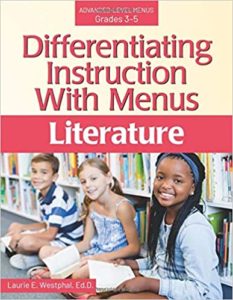Using Menus to Differentiate Literature
Differentiating Instruction with Menus: Literature (Advanced-Level Menus, Grades 3-5)
By Laurie E. Westphal, Ed.D.
(Prufrock Press, 2020 – Learn more)
Reviewed by Sarah Pennington
 Menus are a useful tool for differentiating instruction across many content areas, so I was curious to see how Dr. Laurie Westphal adds to this toolbox with specific ideas for literature in the intermediate grades.
Menus are a useful tool for differentiating instruction across many content areas, so I was curious to see how Dr. Laurie Westphal adds to this toolbox with specific ideas for literature in the intermediate grades.
Although I am not a beginner when it comes to using and designing menu projects, I am always on the lookout for additional menu formats as well as options to provide my students.
This book did not disappoint on either count. There are, however, some concerns in this text that do need to be addressed.
 The first four chapters provide rationale for using menus and practical guidelines for those who haven’t delved into this method of differentiation previously.
The first four chapters provide rationale for using menus and practical guidelines for those who haven’t delved into this method of differentiation previously.
Chapter one offers an overview of each menu format highlighted within the remainder of the book, including benefits and limitations of each.
Chapter two provides guidance on using menus in the classroom for a variety of purposes, including building schema, providing enrichment, and flipping the classroom.
Chapter three gives guidance on creating clear guidelines for the various products that may be included in a menu project, while chapter four completes the process overview with a discussion of rubrics for a menu project.
Overall, these first chapters prove to be a useful guide for those new to using menu projects.
The remainder of the book provides example menu projects for 14 novels and short stories and six poems (with the poems included within the book). For each text the author provides multiple menu formats with multiple challenge levels for each format.
The project ideas for each text provide multiple ways for students to show their understanding of the text while also homing in on specific areas, such as setting, character, and plot.
Positives
One of the concerns I had as a teacher when I began using menu projects was the possible inequity in terms of resources students had available to create their final products. Westphal addresses this in chapter 3 with the idea of a $1 contract, in which the student and their parent/guardian agree that no more than $1 was spent in the creation of a product. This brief contract is a great tool to make sure that everyone in the classroom is on an even playing field when creating their menu projects.
The variety of activities included in the menus provide opportunities for students to create authentic products that have real-world relevance (commercials and newspaper articles) as well as products that provide opportunities for students to share with peers (plays, speeches, videos).
The variety of activities, along with the guidelines for each, can help teachers create balanced and engaging menu projects that are tailored to their students’ strengths and interests.
Have a student who is a budding artist? Include activities like creating an illustrated picture book or a comic strip to the menu! Have a student who loves creating items that will actually be used? Make sure that students can choose to create a playable game or a puppet in the menu. Then let the students choose the project ideas that excite them. They might surprise you and pick something you didn’t expect!
Concerns
In chapter three, Westphal provides a list of products by “learning style.” There are multiple concerns with formatting the list in this way, the first being the myth of “learning styles” as they are commonly used in the classroom. (See here and here for more info.) The language around learning styles is something that needs to be removed in order to stop perpetuating this common education myth.
The texts utilized within this book do not represent a great deal of diversity. In terms of text authorship, there is one Native American author and one Asian American author, with one additional text that features a main character of color (written by a white woman). All the poems are written by white authors. The Secret Garden as one of the included texts is also troubling due to the racism within the text, which is not addressed in any of the menu projects.
Overall Review
This book has some very useful elements, despite my concerns. It provides a variety of excellent activities to involve students in thoughtful and purposeful engagement with and response to texts. For those who, rightfully, strive to include diverse texts in their curriculum, the ideas from this book serve as an inspiration point for projects that can be used for a wider variety of texts with little modification.
Dr. Sarah E. Pennington taught middle school language arts for a decade before returning to school to pursue her doctoral degree in curriculum and instruction. She is currently an assistant professor at Montana State University, where she teaches pre-service educators the ins and outs of supporting young literacy learners. She also provides professional development in literacy and motivation to teachers across the nation.

































